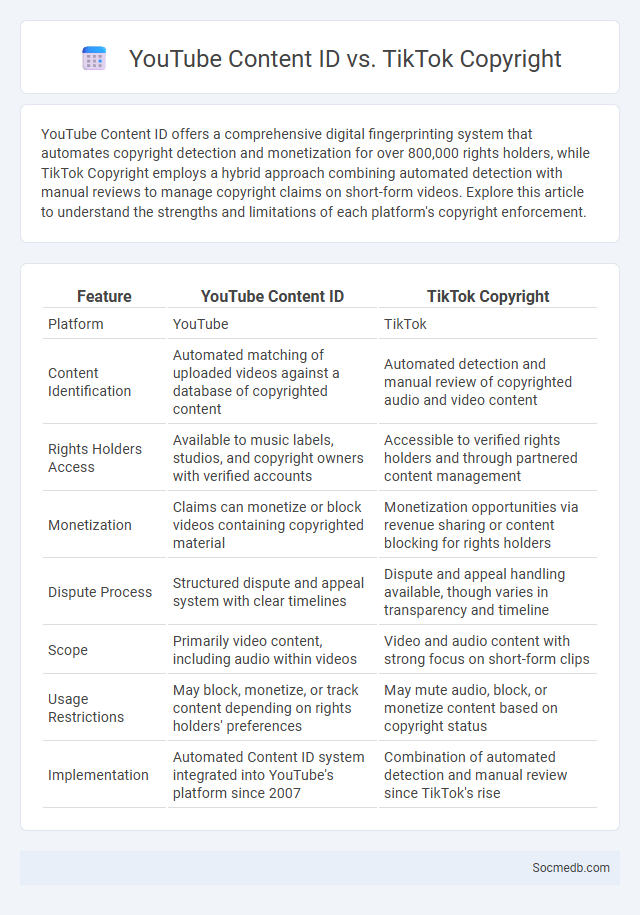
Photo illustration: YouTube Content ID vs TikTok Copyright
YouTube Content ID offers a comprehensive digital fingerprinting system that automates copyright detection and monetization for over 800,000 rights holders, while TikTok Copyright employs a hybrid approach combining automated detection with manual reviews to manage copyright claims on short-form videos. Explore this article to understand the strengths and limitations of each platform's copyright enforcement.
Table of Comparison
| Feature | YouTube Content ID | TikTok Copyright |
|---|---|---|
| Platform | YouTube | TikTok |
| Content Identification | Automated matching of uploaded videos against a database of copyrighted content | Automated detection and manual review of copyrighted audio and video content |
| Rights Holders Access | Available to music labels, studios, and copyright owners with verified accounts | Accessible to verified rights holders and through partnered content management |
| Monetization | Claims can monetize or block videos containing copyrighted material | Monetization opportunities via revenue sharing or content blocking for rights holders |
| Dispute Process | Structured dispute and appeal system with clear timelines | Dispute and appeal handling available, though varies in transparency and timeline |
| Scope | Primarily video content, including audio within videos | Video and audio content with strong focus on short-form clips |
| Usage Restrictions | May block, monetize, or track content depending on rights holders' preferences | May mute audio, block, or monetize content based on copyright status |
| Implementation | Automated Content ID system integrated into YouTube's platform since 2007 | Combination of automated detection and manual review since TikTok's rise |
Overview of Digital Copyright in Social Media Platforms
Digital copyright on social media platforms encompasses the protection of original content such as images, videos, and written posts shared by users, governed by laws like the Digital Millennium Copyright Act (DMCA) and international agreements. Social media companies implement automated content recognition systems and strict takedown policies to prevent unauthorized distribution and infringement of copyrighted material. Enforcement challenges persist due to the vast volume of user-generated content, requiring ongoing improvements in technology and legal frameworks to balance copyright protection with freedom of expression.
What is YouTube Content ID?
YouTube Content ID is an advanced digital fingerprinting system used by YouTube to automatically identify and manage copyrighted content across its platform. This tool scans uploaded videos against a vast database of audio and visual files, enabling copyright holders to claim, track, or monetize unauthorized use of their work. By understanding how Content ID works, you can better protect your original content and comply with copyright regulations on YouTube.
How TikTok Handles Copyright Protection
TikTok employs advanced content recognition technology to identify and manage copyrighted material, ensuring that creators' intellectual property is protected. It utilizes automated systems that detect unauthorized uploads and prompt users to remove infringing content or dispute claims through a structured process. Your ability to share creative content on TikTok is balanced with robust copyright enforcement to maintain a fair digital environment.
Comparing YouTube Content ID and TikTok Copyright Systems
YouTube Content ID offers a sophisticated automated system that scans videos against a vast database of copyrighted material, enabling copyright owners to monetize, track, or block unauthorized content. TikTok's copyright system relies more on a mix of automated detection and user reports to manage infringements, with a focus on rapid content removal and a smaller database of rights holders. Your choice between these platforms should consider YouTube's advanced rights management capabilities versus TikTok's more dynamic, fast-response approach to copyright enforcement.
Content Identification Technologies: Key Differences
Content Identification Technologies in social media primarily differ in their approach to detecting copyrighted material, employing fingerprinting, watermarking, and metadata analysis. Fingerprinting analyzes unique audio or visual patterns to identify content regardless of alterations, while watermarking embeds invisible signals directly into the media. Metadata analysis relies on associated data tags, which can be easily manipulated, making fingerprinting the most robust method for accurate content identification.
User Experience: Uploading Copyrighted Content
Uploading copyrighted content on social media platforms can lead to account suspension, content removal, or legal consequences due to strict copyright enforcement policies. Your user experience improves when you respect intellectual property rights by sharing original or properly licensed media, ensuring smoother interaction and fewer disruptions. Social media algorithms also prioritize authentic content, increasing your visibility and engagement when you comply with copyright guidelines.
Rights Management and Monetization Opportunities
Social media platforms implement advanced rights management systems to protect creators' intellectual property and ensure proper attribution across content-sharing networks. These systems enable monetization opportunities through features like ad revenue sharing, sponsored content, and subscription models, allowing creators to generate income from their digital assets. Effective rights management tools also facilitate automated copyright enforcement and licensing agreements, maximizing revenue potential while safeguarding creator rights.
Dispute Resolution Mechanisms on YouTube vs TikTok
Dispute resolution mechanisms on YouTube leverage an extensive content ID system and a multi-tiered appeal process to address copyright claims, strikes, and community guidelines violations efficiently. TikTok offers a streamlined, in-app dispute process focusing on rapid review and resolution but with fewer detailed steps compared to YouTube's comprehensive approach. Understanding these platforms' differences helps you navigate content disputes effectively and protect your digital rights.
Common Challenges and Limitations of Each System
Social media platforms face common challenges such as data privacy concerns, algorithmic bias, and the spread of misinformation, which affect user trust and engagement. Limited content moderation capabilities lead to persistent issues with hate speech, cyberbullying, and harmful content across networks like Facebook, Twitter, and Instagram. Technical limitations, including bandwidth constraints and platform-specific restrictions, also hinder seamless user experience and cross-platform integration.
Best Practices for Creators Navigating Content Copyright
Creators should always secure explicit permission or licenses before using any third-party content to avoid copyright infringement. Implementing consistent content attribution and monitoring platforms for unauthorized use protects your intellectual property rights. Understanding platform-specific copyright rules and promptly responding to infringement claims ensures sustainable and compliant content creation.
 socmedb.com
socmedb.com